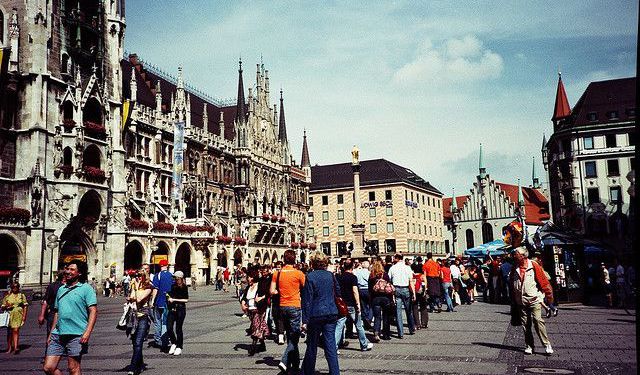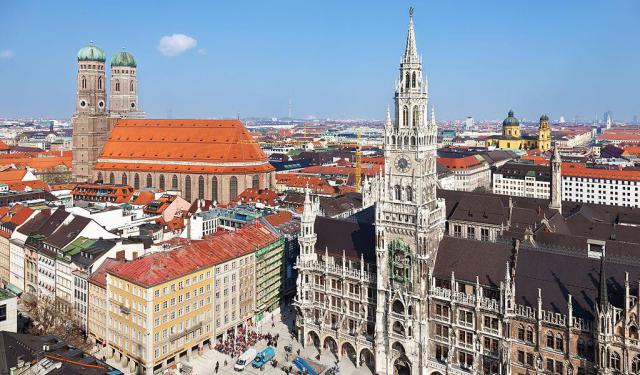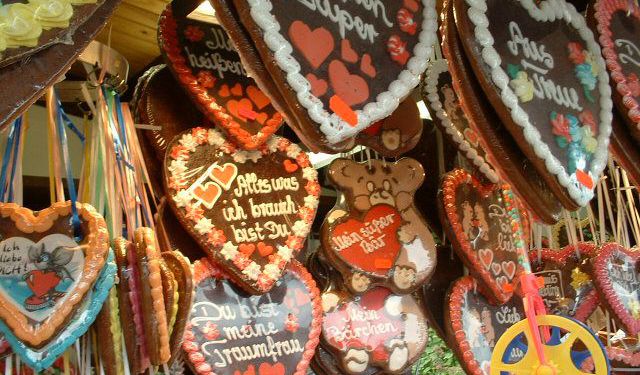
Neues Rathaus (New Town Hall), Munich (must see)
The New Town Hall in Munich was constructed during the 19th century when the city was experiencing significant growth and prosperity. The existing Old Town Hall was too small to accommodate the needs of the local government, necessitating the construction of a new hall.
The chosen location for the New Town Hall was nearby, but it required the demolition of twelve buildings to clear the space. The construction of the hall took place between 1867 and 1908 and was designed by a young architect named Georg Hauberrisser, who was only 24 years old at the time.
The building showcases a Gothic Revival architectural style and boasts an impressive 400 rooms, covering an area of more than 9,000 square meters. Positioned overlooking Marienplatz, it also features a small garden at the rear, known as the Marienhof. In the basement, there's the Ratskeller restaurant. The first-floor balcony often opens for visitors to watch events in Marienplatz. The 85-meter-tall main tower has elevators for access.
One of the main attractions of the New Town Hall is the mechanical Glockenspiel, a two-level carillon consisting of 43 bells and 32 life-sized figures, dating back to 1908. It performs a chiming and re-enacts two stories from the 16th century daily at 11am, 12pm, and 5pm during the summer months. The first story tells of Duke Wilhelm V marrying Renata of Lorraine, with a joust between life-sized knights on horseback, one representing Bavaria (white and blue) and the other Lothringen (red and white), with the Bavarian knight winning.
The second story, known as the Schäfflertanz (the coopers' dance), is set in 1517 during a plague outbreak in Munich. Legend has it that coopers, loyal to the duke, danced through the streets to inspire courage during tough times. This dance now represents resilience. It's performed in Munich every seven years during Fasching (German Carnival). Surprisingly, the official dance moves were defined in 1871, despite being described as an ancient tradition since 1700.
The entire Glockenspiel performance lasts between 12 and 15 minutes, depending on the selected tune for the day. As a concluding touch, a small golden rooster at the top of the Glockenspiel quietly chirps three times, marking the end of this captivating spectacle.
The chosen location for the New Town Hall was nearby, but it required the demolition of twelve buildings to clear the space. The construction of the hall took place between 1867 and 1908 and was designed by a young architect named Georg Hauberrisser, who was only 24 years old at the time.
The building showcases a Gothic Revival architectural style and boasts an impressive 400 rooms, covering an area of more than 9,000 square meters. Positioned overlooking Marienplatz, it also features a small garden at the rear, known as the Marienhof. In the basement, there's the Ratskeller restaurant. The first-floor balcony often opens for visitors to watch events in Marienplatz. The 85-meter-tall main tower has elevators for access.
One of the main attractions of the New Town Hall is the mechanical Glockenspiel, a two-level carillon consisting of 43 bells and 32 life-sized figures, dating back to 1908. It performs a chiming and re-enacts two stories from the 16th century daily at 11am, 12pm, and 5pm during the summer months. The first story tells of Duke Wilhelm V marrying Renata of Lorraine, with a joust between life-sized knights on horseback, one representing Bavaria (white and blue) and the other Lothringen (red and white), with the Bavarian knight winning.
The second story, known as the Schäfflertanz (the coopers' dance), is set in 1517 during a plague outbreak in Munich. Legend has it that coopers, loyal to the duke, danced through the streets to inspire courage during tough times. This dance now represents resilience. It's performed in Munich every seven years during Fasching (German Carnival). Surprisingly, the official dance moves were defined in 1871, despite being described as an ancient tradition since 1700.
The entire Glockenspiel performance lasts between 12 and 15 minutes, depending on the selected tune for the day. As a concluding touch, a small golden rooster at the top of the Glockenspiel quietly chirps three times, marking the end of this captivating spectacle.
Want to visit this sight? Check out these Self-Guided Walking Tours in Munich. Alternatively, you can download the mobile app "GPSmyCity: Walks in 1K+ Cities" from Apple App Store or Google Play Store. The app turns your mobile device to a personal tour guide and it works offline, so no data plan is needed when traveling abroad.
Neues Rathaus (New Town Hall) on Map
Sight Name: Neues Rathaus (New Town Hall)
Sight Location: Munich, Germany (See walking tours in Munich)
Sight Type: Attraction/Landmark
Guide(s) Containing This Sight:
Sight Location: Munich, Germany (See walking tours in Munich)
Sight Type: Attraction/Landmark
Guide(s) Containing This Sight:
Walking Tours in Munich, Germany
Create Your Own Walk in Munich
Creating your own self-guided walk in Munich is easy and fun. Choose the city attractions that you want to see and a walk route map will be created just for you. You can even set your hotel as the start point of the walk.
Old Town Walking Tour
The Old Town of Munich, sprawling on the west bank of the River Isar, is a treasure trove of architectural splendor and cultural heritage. Also known in German as Altstadt, this medieval area forms the historic core and cultural heart of the Bavarian capital. The entire Old Town is listed as a historical monument and is a living museum – “where the past harmonizes with the present in a grand... view more
Tour Duration: 2 Hour(s)
Travel Distance: 2.7 Km or 1.7 Miles
Tour Duration: 2 Hour(s)
Travel Distance: 2.7 Km or 1.7 Miles
Munich Introduction Walking Tour
Straddling the banks of the River Isar north of the Bavarian Alps, Bavaria’s capital Munich is home to centuries-old buildings and numerous attractions.
The city was first mentioned in 1158. Its name is usually interpreted as the Old/Middle High German term Munichen, which means "by the monks", deriving from the monks of the Benedictine order, who ran a monastery at the place that... view more
Tour Duration: 2 Hour(s)
Travel Distance: 2.5 Km or 1.6 Miles
The city was first mentioned in 1158. Its name is usually interpreted as the Old/Middle High German term Munichen, which means "by the monks", deriving from the monks of the Benedictine order, who ran a monastery at the place that... view more
Tour Duration: 2 Hour(s)
Travel Distance: 2.5 Km or 1.6 Miles
Third Reich Munich Walking Tour
In the first quarter of the 20th century, the capital of Bavaria, Munich, was ill-fated to become the birthplace of the National Socialist German Workers' Party (aka NSDAP or Nazi Party) and the site of its early activities. The city played a significant role in the rise and consolidation of power of the Nazi Party and, ultimately, the establishment of the Third Reich.
The Third Reich went... view more
Tour Duration: 2 Hour(s)
Travel Distance: 3.3 Km or 2.1 Miles
The Third Reich went... view more
Tour Duration: 2 Hour(s)
Travel Distance: 3.3 Km or 2.1 Miles
Old Town Souvenir Shops
"Collect moments, not things," wise men say. In reference to travel, this may be interpreted as the prevalence of experiences and memories over material gains. Still, when it comes to travel mementos, albeit material they are, memories and experiences are primarily what these little (or not so little) tokens are all about.
And it would be a pity to leave Munich without bringing home... view more
Tour Duration: 1 Hour(s)
Travel Distance: 1.5 Km or 0.9 Miles
And it would be a pity to leave Munich without bringing home... view more
Tour Duration: 1 Hour(s)
Travel Distance: 1.5 Km or 0.9 Miles
Useful Travel Guides for Planning Your Trip
Top 10 Cafes and Restaurants in Munich
While there are many restaurants and cafes in downtown Munich for a visitor to choose from, by far not all of them are truly worth visiting. Here's the solid list of quality cafes and restaurants that will add greatly to your Munich experience. Each restaurant and cafe featured here offers...
12 German-Made Things to Buy in Munich
The Bavarian capital Munich, much as the whole state of Bavaria, form an inseparable part of the German image, although a very unique part in its difference to the rest of the country, including the language. Bavarian beer occupies an important place in German heritage, from the infamous 1920s Beer...






